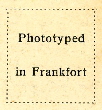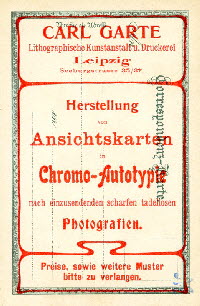|
Identifying (German) postcard printers
This is something only for the die-hard ppc collector. It needs plenty of time, requires an own bigger (or access to a) ppc collection to compare, a good eye for details and best some knowledge of (old) printing processes and their characteristics. Furthermore it is very helpful to get access to old paper/printing trade publications. Often they contain valuable information/advertising helpful for identification trademarks, logos etc.
We are talking about cards from worldwide. Some countr ies required an imprint on imported ppc’s with country of origin. “Printed abroad” / “Importe” however is not really helpful. “Printed in Germany” is also not rewarding. “Printed at our/the works in Hamburg”, “Printed in Hessia, .. in Saxony, .. in Bavaria”, Phototyped at Dresden” etc. is of course much better and limits a little bit the circle of potential firms involved. ies required an imprint on imported ppc’s with country of origin. “Printed abroad” / “Importe” however is not really helpful. “Printed in Germany” is also not rewarding. “Printed at our/the works in Hamburg”, “Printed in Hessia, .. in Saxony, .. in Bavaria”, Phototyped at Dresden” etc. is of course much better and limits a little bit the circle of potential firms involved.
Many ppc’s however, show no such imprint (or is hidden below postage stamp) but a plain number only or nothing of interest at all. This was also due to requirements of the customer, in many cases jobbers/middlemen, who did not want anything on cards except their own or local publishers name.
Let’s say you collect ppc’s from a regional publisher who possibly ordered also from abroad, and now you would like to find out where they did come from. Following hints could be helpful for research.
 Printing sample cards Printing sample cards
This is of course perfect for identification. Printers usually had a number of different printing styles and qualities on offer. They issued printing sample cards to show to customers directly or via travelling salesmen. Usually they took cards they had previously printed (and came out well of course) and added imprints with information on printing style and -name, (minimum) quantities to be ordered, sometimes also prices and how delivery takes and so on.
Another type of sample card show printer name only, often just a rubber stamp imprint with or without printing process name mentioned.
A third type found shows a printed picture side but with blank reverse. These were either for jobbers/middlemen or to be pasted into albums with printing samples and the interesting information imprinted below cards. Unless you have the complete album or the design style/quality of card is very characteristic these are rarely much of use.
Imprinted initials
Some printers put their initials in regular type with or without card/job number on ppc’s. Sometimes in very small type or hidden inside picture/ornaments etc. Usually the first initials stand for the printer or publisher company name and the last for the city. But there are also exceptions from this rule! This requires some guesswork and best more cards from other countries to compare. Often somewhere a card with full name and of same design turns up.
More often any initials found imprinted stood for the postcard publisher but not the printer. T.S.N. stood for Theo Stroefer from Nuernberg (Nuremberg). This old, big publishing firm (many of their cards were printed by the local big printing company E. Nister, others by Bruckmann, Munich) used also a special designed logo on cards, however. Another example is F.E.D. = publisher Friedrich Eyfried, Duesseldorf.
B.K.W.I. was used by the big Austrian postcard publishers Br ueder Kohn from Wien (Vienna) I (post office 1 / downtown). The last initial is often misinterpreted to stand for a capital ‘I’ but should be correctly read as a Latin 1 = downtown Vienna postal district. This big publishing firm used the initials on their huge out put of cards quite consequently, sometimes with card number / series information next to initials. ueder Kohn from Wien (Vienna) I (post office 1 / downtown). The last initial is often misinterpreted to stand for a capital ‘I’ but should be correctly read as a Latin 1 = downtown Vienna postal district. This big publishing firm used the initials on their huge out put of cards quite consequently, sometimes with card number / series information next to initials.
Another good example is B.B. & O.L., sometimes it reads B.B. & O. i. L. and with suffix “GmbH” = limited company. This is a combination of the company initials together with that of the city. This was the printer and publisher Bruno Buerger & Ottilie from the city of Leipzig, Saxony. Although “Ottilie” was normally a female surname then it stood here for the business partner “Carl Ottilie”
|